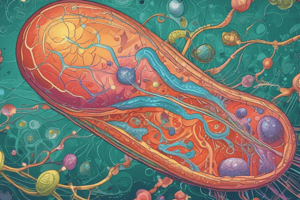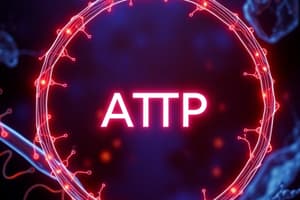Podcast
Questions and Answers
Which of the following best describes the primary role of cellular respiration?
Which of the following best describes the primary role of cellular respiration?
- To synthesize glucose molecules from carbon dioxide and water.
- To build complex proteins from amino acids within the cell.
- To transport oxygen to cells for various metabolic processes.
- To break down food molecules and release energy in the form of ATP. (correct)
In eukaryotic cells, where does the majority of cellular respiration take place?
In eukaryotic cells, where does the majority of cellular respiration take place?
- The endoplasmic reticulum.
- The Golgi apparatus.
- The mitochondria. (correct)
- The nucleus.
What distinguishes aerobic cellular respiration from anaerobic cellular respiration?
What distinguishes aerobic cellular respiration from anaerobic cellular respiration?
- Aerobic respiration is exclusive to prokaryotic cells, while anaerobic respiration is exclusive to eukaryotic cells.
- Aerobic respiration uses carbon dioxide, while anaerobic respiration uses oxygen.
- Aerobic respiration produces more ATP than anaerobic respiration. (correct)
- Aerobic respiration occurs in the cytoplasm, while anaerobic respiration occurs in the mitochondria.
How does the breakdown of ATP contribute to cellular functions?
How does the breakdown of ATP contribute to cellular functions?
What would happen if a cell's mitochondria were not functioning correctly?
What would happen if a cell's mitochondria were not functioning correctly?
Flashcards
Cellular Respiration
Cellular Respiration
The metabolic process by which cells obtain chemical energy from food by breaking the bonds of food molecules like glucose
Mitochondrion
Mitochondrion
An organelle within eukaryotic cells that acts as the main location for energy production
ATP
ATP
Abbreviation for adenosine triphosphate, it is the main form of energy currency utilized by cells
Aerobic Cellular Respiration
Aerobic Cellular Respiration
Signup and view all the flashcards
Anaerobic Respiration
Anaerobic Respiration
Signup and view all the flashcards
Study Notes
- Cellular respiration is the metabolic process where living cells obtain chemical energy from food by breaking the chemical bonds within food molecules, such as glucose.
- It's crucial for organisms to acquire the energy needed for survival and normal activities.
Location of Cellular Respiration
- In eukaryotic cells, the mitochondrion is the primary site for cellular energy production.
- A glucose molecule goes through several steps to extract energy in the form of ATP (adenosine triphosphate).
- Many cells use oxygen in the final steps of cellular respiration to release energy from food molecules, known as aerobic cellular respiration.
- Most cellular respiration reactions in eukaryotic organisms occur in the mitochondria.
- The breakdown of different food molecules produces a varying number of ATP molecules, utilized by cells like muscle and nerve cells.
- Cellular respiration can occur with or without oxygen.
Types of Cellular Respiration
- There are two main types: aerobic and anaerobic.
- Aerobic respiration occurs in the presence of oxygen.
- Anaerobic respiration occurs in the absence of oxygen.
Stages of Aerobic Cellular Respiration
- Aerobic cellular respiration involves three major stages:
- Glycolysis
- Krebs cycle (citric acid cycle)
- Oxidative phosphorylation (including the electron transport chain)
- Oxygen is required for aerobic respiration, which produces more net ATP than anaerobic processes.
Stage 1: Glycolysis
- Glycolysis occurs in the cytoplasm.
- A six-carbon glucose molecule is broken down into two three-carbon pyruvate molecules.
- Carbon dioxide and ATP are produced by substrate-level phosphorylation.
- Glycolysis does not require oxygen.
- Starting materials: glucose, ATP, ADP, NAD+, and a phosphate molecule.
- Products: two pyruvate, two NADH, and two net ATP.
- Although four ATP molecules are produced, two ATP are consumed during glycolysis.
Stage 2: Transition Reaction/Bridge Reaction/Formation of Acetyl CoA
- Pyruvate molecules enter the mitochondria and are broken down and combined with coenzyme A (CoA) to form acetyl-CoA.
- Carbon dioxide is released, and hydrogen atoms are transferred to NAD+.
- Links glycolysis to the Krebs cycle.
- Starting materials: pyruvate, NAD+, and coenzyme A.
- Products: acetyl-CoA, carbon dioxide, and NADH.
Stage 3: Krebs Cycle/Citric Acid Cycle
- Occurs in the mitochondria.
- Acetyl portion of acetyl CoA is broken down into carbon dioxide.
- ATP is released, and hydrogen atoms are transferred to NAD+ and FAD.
- The cycle occurs twice per glucose molecule.
- Starting materials: acetyl CoA, NAD+, FAD, ADP, and a phosphate molecule.
- Products: 6 carbon dioxide, 8 NADH, 2 FADH2, and 2 ATP.
Stage 4: Oxidative Phosphorylation
- Involves the electron transport chain and chemiosmosis.
- Occurs in the mitochondria in eukaryotes.
- NADH and FADH2 from previous stages are used to create a large number of ATP molecules.
- The electron transport chain involves carrier proteins, NADH, and FADH2.
- Carrier proteins transfer electrons, releasing hydrogen molecules (H+).
- Oxygen acts as the final electron acceptor in the electron transport chain.
- H+ molecules are pumped into the intermembrane space, creating an electrochemical gradient that powers ATP synthase to produce ATP.
- Starting materials: NADH, FADH2, oxygen, ADP, and a phosphate molecule.
- Products: Typically 32 ATP, NAD+, FAD, and water.
- The breakdown of one glucose molecule yields 36 net ATP molecules under aerobic respiration.
Anaerobic Respiration Processes
- Fermentation may follow glycolysis in anaerobic organisms.
- Pyruvate undergoes substrate-level phosphorylation, yielding small amounts of ATP.
- Byproducts depend on the cell type (e.g., lactic acid in mammalian cells, ethanol in yeast cells).
- Anaerobic cellular respiration uses a molecule other than oxygen, such as sulfur, as the final electron acceptor in the electron transport chain.
Cellular Respiration Equation
- Glucose is extracted from a food source or stored glycogen and turned into pyruvate in glycolysis.
- After glycolysis, the pyruvate is converted into acetyl-CoA and sent into the Krebs cycle, followed by the electron transport chain.
Importance of Cellular Respiration
- Cellular respiration breaks down food molecules to release cellular energy as ATP, "the energy currency of cells."
- All cells require energy, making cellular respiration essential for life.
- During anaerobic and aerobic processes, organic molecules (e.g., glucose) are used to create ATP.
- All living organisms carry out some form of cellular respiration.
Reactants of Cellular Respiration
- Initial reactants are food energy molecules like glucose.
- In aerobic respiration, products are ATP, water, and carbon dioxide.
- Metabolic waste products differ between aerobic and anaerobic processes. Aerobic cellular respiration reactants include a food energy molecule such as glucose, and oxygen which acts as the final electron acceptor during the electron transport chain during oxidative phosphorylation.
- In anaerobic respiration, molecules other than oxygen (e.g., sulfur) are used as electron acceptors.
Studying That Suits You
Use AI to generate personalized quizzes and flashcards to suit your learning preferences.




